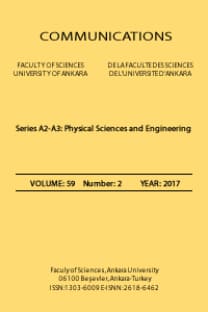A NEW SIMILARITY COEFFICIENT FOR A COLLABORATIVE FILTERING ALGORITHM
Recommendation systems, collaborative filtering, user similarity
___
Sincan, O.M., Yildirim, Z., “Video recommendation system using collaborative filtering”, International Conference on Advances in Science and Arts ICASA'2017, ( 2017).Goldberg, D., Nichols, D., Oki, B. M., Terry, D. “Using collaborative filtering to weave an information tapestry.” Communications of the ACM, 35/12 (1992) 61-70.
Resnick, P., Iacovou, N., Suchak, M., Bergstrom, P., Riedl, J. “GroupLens: an open architecture for collaborative filtering of netnews.” In Proceedings of the 1994 ACM conference on Computer supported cooperative work, (1994), p. 175-186.
Breese, J. S., Heckerman, D., Kadie, C. “Empirical analysis of predictive algorithms for collaborative filtering.” In Proceedings of the Fourteenth conference on Uncertainty in artificial intelligence, (1998), p. 43-52.
Herlocker, J. L., Konstan, J. A., Riedl, J. “Explaining collaborative filtering recommendations.” In Proceedings of the 2000 ACM conference on Computer supported cooperative work, (2000), p. 241-250.
Yu, K., Schwaighofer, A., Tresp, V., Xu, X., Kriegel, H. P. “Probabilistic memory-based collaborative filtering.” IEEE Transactions on Knowledge and Data Engineering, 16/1(2004) 56-69.
Yang, J. M., Li, K. F. “Recommendation based on rational inferences in collaborative filtering.” Knowledge-Based Systems, 22/1 (2009) 105-114.
Adamopoulos, P., Tuzhilin, A. “Recommendation opportunities: improving item prediction using weighted percentile methods in collaborative filtering systems.” In Proceedings of the 7th ACM conference on Recommender systems, (2013), p. 351-354).
Bulut, H., Milli, M. “İşbirlikçi filtreleme için yeni tahminleme yöntemleri.” Pamukkale Üniversitesi Mühendislik Bilimleri Dergisi, 22/2(2016) 123-128.
Gogna, A., Majumdar, A. “A comprehensive recommender system model: Improving accuracy for both warm and cold start users.” IEEE Access, 3(2015) 2803-2813.
Luo, X., Zhou, M., Xia, Y., Zhu, Q. “An efficient non-negative matrix-factorization-based approach to collaborative filtering for recommender systems.“ IEEE Transactions on Industrial Informatics, 10/2(2014) 1273-1284.
Hernando, A., Bobadilla, J., Ortega, F. “A non negative matrix factorization for collaborative filtering recommender systems based on a Bayesian probabilistic model.” Knowledge-Based Systems, 97(2016), 188-202.
Yang, X., Guo, Y., Liu, Y., Steck, H. “A survey of collaborative filtering based social recommender systems.” Computer Communications, 41(2014) 1-10.
Yang, Z., Wu, B., Zheng, K., Wang, X., Lei, L. “A Survey of Collaborative Filtering-Based Recommender Systems for Mobile Internet Applications.” IEEE Access, 4(2016) 3273-3287.
Mooney, R. J., Roy, L. “Content-based book recommending using learning for text categorization.“ In Proceedings of the fifth ACM conference on Digital libraries, (2000), p. 195-204.
Elahi, M., Ricci, F., Rubens, N. “A survey of active learning in collaborative filtering recommender systems.” Computer Science Review, 20(2016) 29-50.
Lops, P., De Gemmis, M., Semeraro, G. (2011). “Content-based recommender systems: State of the art and trends.” In Recommender systems handbook, (2011), p. 73-105
Semeraro, G., Lops, P., Degemmis, M. “WordNet-based user profiles for neighborhood formation in hybrid recommender systems.” In Hybrid Intelligent Systems, 2005. HIS'05. Fifth International Conference on, (2005), p. 6-pp.
Degemmis, M., Lops, P., Semeraro, G. “A content-collaborative recommender that exploits WordNet-based user profiles for neighborhood formation.“ User Modeling and User-Adapted Interaction, 17/3(2007) 217-255.
Burke, R. “Hybrid recommender systems: Survey and experiments.” User modeling and user-adapted interaction, 12/4(2002) 331-370.
Miller, B. N., Albert, I., Lam, S. K., Konstan, J. A., Riedl, J. “MovieLens unplugged: experiences with an occasionally connected recommender system.” In Proceedings of the 8th international conference on Intelligent user interfaces, (2003), 263-266.
- ISSN: 1303-6009
- Yayın Aralığı: Yılda 2 Sayı
- Başlangıç: 2019
- Yayıncı: Ankara Üniversitesi
INTERPOLATION METHODS FOR RECOVERING THE SAMPLING VALUES OF GPR DATA
A NEW SIMILARITY COEFFICIENT FOR A COLLABORATIVE FILTERING ALGORITHM
Ozge MERCANOGLU SINCAN, Zeynep YILDIRIM
3D VISUALIZATION APPROACH TO GPR DATA
SENTIMENT ANALYSIS USING A RANDOM FOREST CLASSIFIER ON TURKISH WEB COMMENTS
Nergis PERVAN, Hacer YALIM KELEŞ
Entropy squeezing of a multi-photon Jaynes-Cummings atom in the presence of noise
DETECTION OF MUSCLE FATIGUE: RELATIVE STUDY WITH DIFFERENT METHODS
Mohamed REZKİ, Abdelkader BELAİDİ, Mouloud AYAD
Ozge MERCANOGLU SINCAN, Hacer YALIM KELES, Yagmur KIR, Adnan KUSMAN, Bora BASKAK
